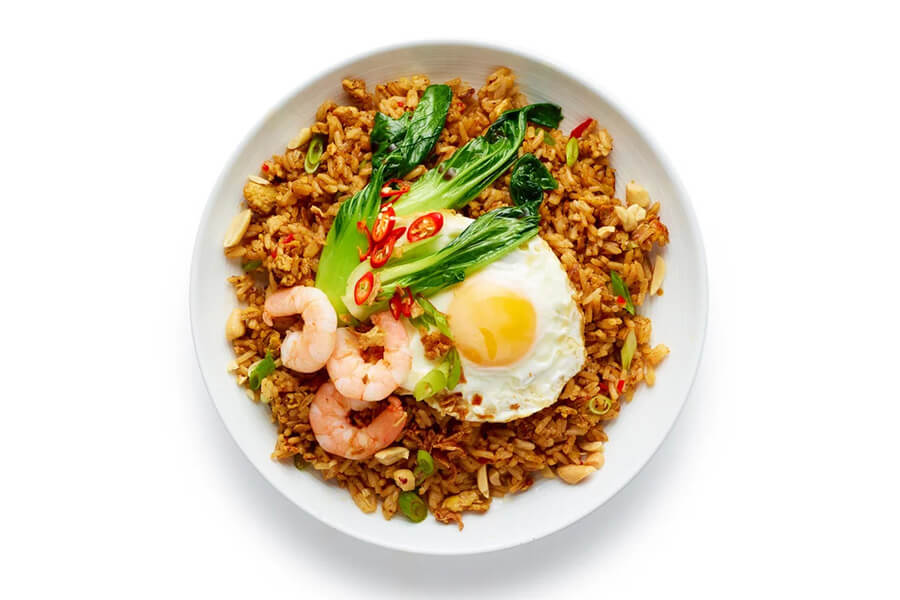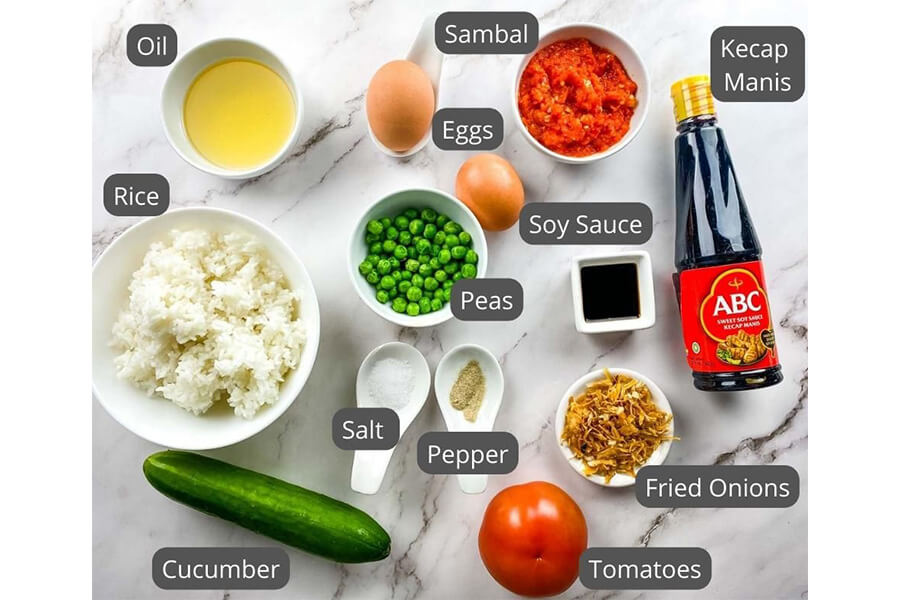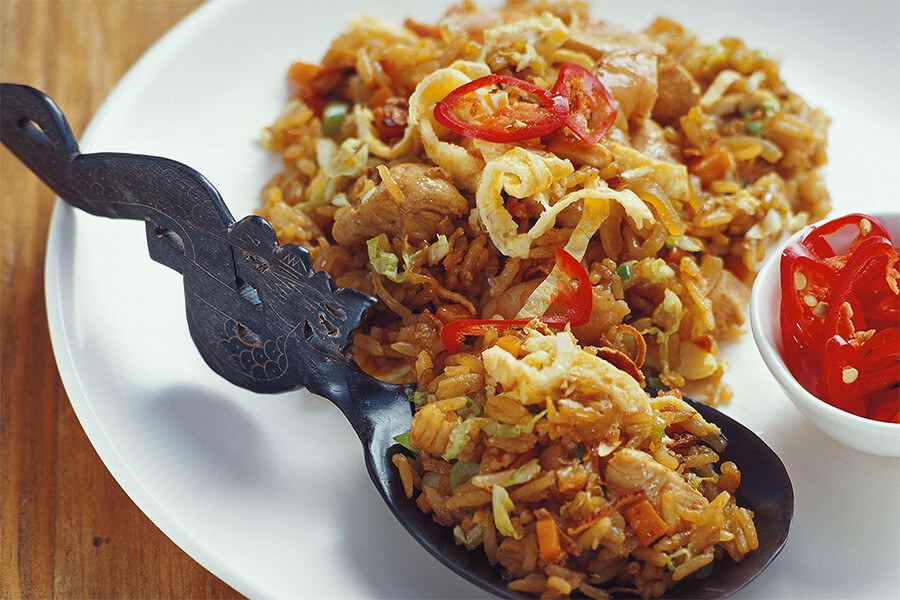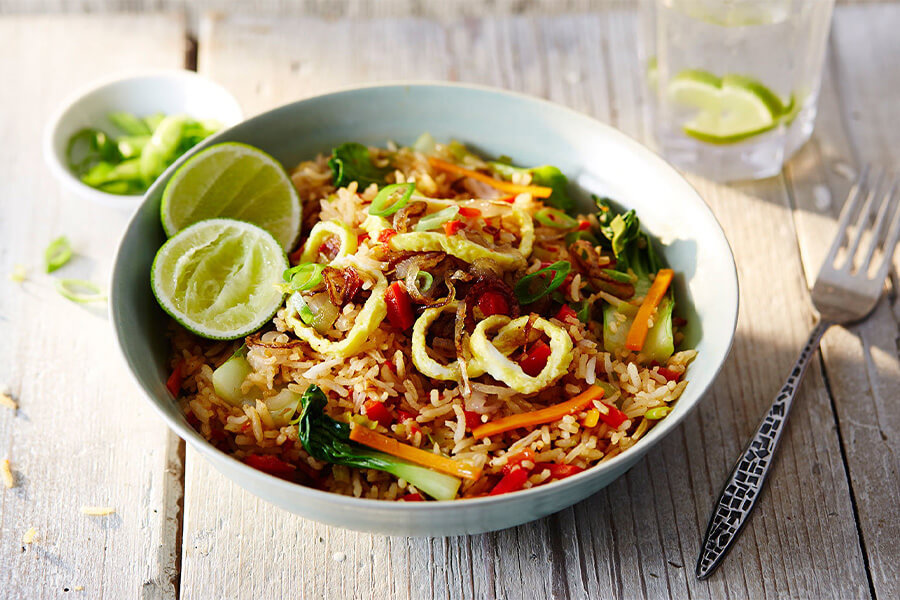If you ask Indonesians which single dish best captures the soul of their cuisine, many will say nasi goreng without hesitation. This humble fried rice is on hotel breakfast buffets, at roadside warung stalls, at beach bars in Bali, and even on the in-flight menus of Indonesian airlines. For travelers, learning how to cook it at home is a delicious way to bring your trip memories back into your kitchen, whether you explored Java and Bali with a local operator like Go Indonesia Tours or planned the journey yourself.
In this guide, I’ll walk you through everything you need to know: what makes a great plate of Indonesian Fried Rice, the essential nasi goreng ingredients, a step-by-step classic nasi goreng recipe, and easy variations you can adapt to your own taste and kitchen.
What Is Nasi Goreng?
In Bahasa Indonesia, “nasi” means rice and “goreng” means fried, so the name literally translates to “fried rice.” But indonesia nasi goreng is more than just rice tossed in a pan. It is smoky, slightly sweet, savory, sometimes spicy, and loaded with umami from kecap manis (sweet soy sauce), shrimp paste, and fried shallots.
Unlike many Chinese-style fried rice dishes, Indonesian Fried Rice is darker in color and often richer in flavor. You’ll usually see it served with a fried egg on top, a few prawn crackers on the side, and simple garnishes like cucumber, tomato, and pickles. It’s a one-plate meal that works for breakfast, lunch, dinner, or a midnight snack.
For many years I’ve used local warung stalls in Jakarta, Yogyakarta, and Bali as my classroom. Watching the cooks move quickly over blazing hot woks, I learned that the magic of this dish is as much about heat, timing, and texture as it is about the seasoning itself.
Essential Nasi Goreng Ingredients
A good fried rice starts with the right base. Before you try any nasi goreng recipe, make sure you understand what each core ingredient contributes to the final flavor and texture.
Key components:
- Cooked rice: Ideally day-old, refrigerated white rice. This gives you dry, separate grains that fry up perfectly instead of turning mushy.
- Aromatics: Finely chopped shallots, garlic, and red chili. These build the flavor backbone.
- Protein: Chicken, shrimp, leftover satay, meatballs, or even tempeh. The dish is extremely forgiving with leftovers.
- Vegetables: Common additions include cabbage, carrot, spring onion, and sometimes long beans or peas.
- Seasonings: Kecap manis (sweet soy sauce), regular soy sauce, salt, white pepper, and sometimes a touch of shrimp paste (terasi) or fish sauce.
- Toppings: Sunny-side-up egg, crispy shallots, prawn crackers (kerupuk), fresh cucumber, tomato, and pickled vegetables (acar).
When you look at recipes from Indonesian home cooks, you’ll notice that the exact fried rice ingredients vary from household to household. That flexibility is part of the charm: once you master the basic technique, you can transform whatever is in your fridge into a satisfying, restaurant-quality plate of nasi goreng.
Classic Indonesian Nasi Goreng Recipe (Street-Style)
This version is inspired by what you’ll find at late-night stalls in Jakarta or Surabaya—smoky, slightly sweet, and deeply savory. It’s the kind of indonesian nasi goreng you might crave long after your trip ends.
Ingredients
- 3 cups cooked, cold white rice (preferably day-old)
- 2 tbsp vegetable oil
- 3 small shallots, finely sliced
- 3 cloves garlic, finely chopped
- 2–3 red chilies, sliced (adjust to your heat tolerance)
- 100 g chicken thigh, thinly sliced (or leftover roast chicken)
- 6–8 medium shrimp, peeled and deveined (optional but recommended)
- 1 small carrot, finely diced
- 1 small handful finely shredded cabbage
- 2 tbsp kecap manis (sweet soy sauce)
- 1 tbsp light soy sauce
- 1/2 tsp shrimp paste (terasi), toasted in a dry pan
- 1/4 tsp white pepper
- Salt to taste
- 2 eggs, fried sunny-side up
- Crispy shallots, prawn crackers, cucumber, tomato, and lime wedges to serve
These are the core nasi goreng ingredients you’ll see again and again in Indonesian kitchens and cooking classes.
Method
- Prepare the rice. Break up any clumps with your fingers or a fork so the grains are loose.
- Heat the wok. Heat the oil in a wok or large frying pan over high heat until shimmering.
- Fry the aromatics. Add the shallots, garlic, and chili. Stir-fry for 30–45 seconds until fragrant and just starting to color.
- Cook the protein. Add the chicken and stir-fry until almost cooked through. If using shrimp, add them next and cook until just pink.
- Add vegetables. Toss in the carrot and cabbage. Stir-fry for 1–2 minutes until the vegetables are tender-crisp.
- Add shrimp paste. Add the shrimp paste and stir quickly to break it up and distribute the flavor.
- Add rice and sauces. Add the rice, kecap manis, light soy sauce, white pepper, and a pinch of salt. Use a spatula to press and toss the rice, making sure every grain is coated and picking up the browned bits from the bottom of the pan.
- Work fast over high heat. Keep the heat high but move quickly. The goal is for the rice to be hot, lightly smoky, and still fluffy.
- Taste and adjust. Taste and adjust the seasoning with more kecap manis, soy sauce, or salt if needed.
- Serve. Divide between plates, top each with a fried egg, and garnish with crispy shallots, cucumber, tomato, prawn crackers, and a squeeze of lime.
Once you’ve cooked this classic nasi goreng recipe a few times, you’ll understand the rhythm of a proper plate of nasi goreng: quick, decisive movements over high heat, with the seasoning added gradually so you keep control of the flavor.
Regional and Creative Variations
One of the pleasures of traveling across Indonesia is discovering how each region puts its own spin on Indonesian Fried Rice. You can bring that diversity into your own kitchen by playing with the basic nasi goreng recipe.
Popular styles include:
- Village-style fried rice (nasi goreng kampung): Usually spicier, lighter on kecap manis, and sometimes fried in coconut oil. Often includes anchovies or dried fish for an extra punch of flavor.
- Javanese fried rice (nasi goreng jawa): Javanese style with more sweetness from extra kecap manis and often served slightly wetter.
- Seafood nasi goreng: Packed with prawns, squid, and sometimes fish. Great if you love coastal flavors or want to recreate meals from beachside warung in Bali or Lombok.
- Fried rice with petai (nasi goreng pete): Made with stinky beans (petai), which have a strong aroma that Indonesians adore. Visitors usually either fall in love with it or avoid it completely!
- Vegetarian or vegan fried rice: Use tofu and tempeh as your main protein and swap fish or shrimp paste for a vegetarian seasoning. It’s still deeply satisfying.
If you spent time in Jakarta, you might remember street vendors who push carts labeled simply “NASI GORENG” through quiet neighborhoods at night. Many of them will happily customize the dish to your taste—extra spicy, no egg, more crackers, or with particular leftovers added. Use that same spirit of flexibility at home and you’ll never make the same plate of nasi goreng twice.
How Indonesians Eat Fried Rice
Understanding how locals actually enjoy this dish will help you decide when and how to serve it. In many Indonesian homes, nasi goreng is a clever way to use leftover rice and protein from the previous day. It appears on the breakfast table with sliced cucumber and hot tea, or as a fast dinner when everyone comes home at different times.
In cities like Jakarta and Bandung, it’s also a classic late-night comfort food. Students grab plates of Indonesian Fried Rice at roadside tents after classes, drivers stop for a quick meal at 2 a.m., and families order it through delivery apps when they want something familiar but flavorful.
Because the dish is so adaptable, it also fits easily into Western mealtime habits. You can serve indonesia nasi goreng for brunch with extra vegetables and a salad, or for dinner alongside grilled chicken satay, peanut sauce, and a simple soup.
Pro Tips for Perfect Indonesian Fried Rice at Home
After eating and cooking countless plates of Indonesian Fried Rice across the archipelago, I’ve learned a few practical tricks that make a big difference to your results:
Use day-old rice
Freshly cooked rice holds too much moisture and tends to clump. Spread hot rice on a tray to cool quickly, then refrigerate for several hours or overnight. This gives you the firm, separate grains you need for a proper nasi goreng.
Control the heat
A traditional street cart uses fierce charcoal or gas flames that give a slight smoky aroma. At home, use the biggest burner you have and preheat your wok or pan thoroughly. If your stove is weak, fry in smaller batches so you don’t overcrowd the pan and drop the temperature.
Balance sweet, salty, and spicy
The signature flavor profile of indonesian nasi goreng comes from balancing kecap manis, regular soy, salt, and chili. Start with the recipe quantities, then taste and adjust. If it tastes flat, you probably need more soy or salt. If it’s too salty, a drizzle of kecap manis and a squeeze of lime can bring it back into harmony.
Prep everything before you start
Once your wok is hot, things move quickly. Have all your chopped vegetables, protein, sauces, and rice ready to go within arm’s reach. This “mise en place” approach is exactly what you’ll see in professional kitchens and street stalls alike.
Customize the protein
One of the joys of this dish is using whatever you have. Leftover roast chicken, grilled beef from last night’s barbecue, or even diced sausage can all turn into a great batch of Indonesian Fried Rice. Just cut the pieces small so they heat quickly without drying out.
Common Mistakes and How to Fix Them
Even experienced cooks run into trouble with fried rice. Here are some frequent issues and how to avoid them:
Rice turning mushy
This usually happens because the rice was freshly cooked or too wet. Next time, use day-old rice or cook your rice with slightly less water. You can also spread freshly cooked rice on a tray and refrigerate uncovered for an hour before frying your nasi goreng.
Lack of flavor
If your fried rice tastes bland, you may be missing umami elements. Try adding a bit more shrimp paste, fish sauce, or even a sprinkle of chicken stock powder. Don’t skip the garnishes: fried shallots, lime, and prawn crackers add layers of texture and taste that round out a plate of indonesian nasi goreng.
No “wok hei” (smoky aroma)
Most home stoves can’t duplicate the extreme heat of a Jakarta street cart, but you can come close by preheating your pan properly and working in small batches. Avoid stirring constantly; give the rice a few seconds to sear against the pan before tossing again.
Egg overcooked or undercooked
The runny yolk of a perfectly fried egg is part of the pleasure of a restaurant-style nasi goreng. Fry the egg in a separate small pan over medium-high heat so you can control it precisely. The whites should be crisp at the edges but the yolk still fluid enough to mix into the rice.
Serving Ideas and Pairings
While a plate of fried rice with egg is a complete meal on its own, pairing it with other dishes can turn a simple dinner into a full Indonesian feast.
Try serving nasi goreng with:
- Satay skewers and peanut sauce
- Gado-gado (mixed vegetables with peanut dressing)
- A simple clear soup with vegetables and tofu
- Sambal on the side for anyone who likes extra heat
- Iced tea with lime or a cold Indonesian beer
If you’ve traveled through Bali or Java, you may remember hotel breakfasts where the buffet offered both Western items and a chafing dish full of Indonesian Fried Rice. Recreate that experience by serving smaller portions of nasi goreng alongside scrambled eggs, grilled tomatoes, and fresh fruit.
Adapting the Dish for Different Diets
The beauty of this dish is how easily it adapts to different dietary needs without losing its character.
For vegetarians
Use tofu and tempeh as your proteins, skip shrimp paste, and boost umami with mushroom sauce or a vegetarian oyster sauce. Add more vegetables like bell peppers, baby corn, or green beans to your nasi goreng.
For vegans
Follow the vegetarian approach and omit the egg. Top the rice with crispy fried shallots, toasted peanuts, and extra vegetables for richness, creating a satisfying vegan version of Indonesian Fried Rice.
For gluten-free diets
Choose gluten-free soy sauce and make sure your shrimp paste and other seasonings don’t contain wheat. Most other nasi goreng ingredients are naturally gluten-free.
For low-spice eaters
Reduce the fresh chili and serve sambal on the side so people can adjust their own heat level, without losing the soul of indonesian nasi goreng.
Bringing Travel Memories into Your Kitchen
Cooking this dish at home is more than following a nasi goreng recipe; it’s a way of reconnecting with the sounds and smells of Indonesia. As you heat the oil and add garlic and chili, you might remember a vendor in Yogyakarta cooking beside a busy intersection, or the taste of your first plate of Indonesian Fried Rice on a late arrival into Denpasar.
When I teach travelers how to cook nasi goreng in small group cooking classes, the same thing happens: someone always tells a story about a favorite warung, a hostel breakfast, or a rainy night in Jakarta when a plate of hot, fragrant indonesian nasi goreng made everything feel right again. That emotional connection is part of what makes simple food so powerful.








